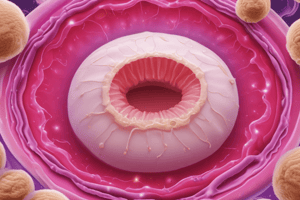Podcast
Questions and Answers
What is the primary purpose of fungal cultures in a microbiology laboratory?
What is the primary purpose of fungal cultures in a microbiology laboratory?
- To detect the presence of bacteria in specimens
- To detect the presence of fungi in specimens (correct)
- To treat fungal infections
- To identify the type of antibiotic to use
What type of specimen is commonly used for fungal cultures?
What type of specimen is commonly used for fungal cultures?
- Urine samples
- Blood samples
- Skin scrapings or nail scrapings (correct)
- Tissue biopsies
What is the purpose of the Plate Exposure method?
What is the purpose of the Plate Exposure method?
- To isolate airborne fungi (correct)
- To identify fungal spores in skin scraping
- To culture fungal specimens from tissue biopsies
- To detect fungal presence in urine samples
What is the main component of the fungal spore cell wall?
What is the main component of the fungal spore cell wall?
What is the purpose of KOH preparation in fungal detection?
What is the purpose of KOH preparation in fungal detection?
What is the purpose of mixing specimen with 20% w/v KOH?
What is the purpose of mixing specimen with 20% w/v KOH?
What is the primary method of diagnosing Candidemia?
What is the primary method of diagnosing Candidemia?
What is the characteristic of Cryptococcus neoformans in culture?
What is the characteristic of Cryptococcus neoformans in culture?
What is the purpose of using India Ink in the diagnosis of Cryptococcus neoformans?
What is the purpose of using India Ink in the diagnosis of Cryptococcus neoformans?
What is the serological diagnostic test for Cryptococcus neoformans?
What is the serological diagnostic test for Cryptococcus neoformans?
Flashcards are hidden until you start studying
Study Notes
Fungi Isolation from Clinical Specimens
- Fungal cultures are used to detect the presence of fungi in patient specimens.
- The laboratory creates optimal conditions to grow and identify fungi in the specimen.
- Specimens can include skin scrapings, nail scrapings, infected hair, etc.
- Plate exposure method is used to isolate airborne fungi, which involves exposing a plate containing PDA to air for a few minutes, then incubating and examining it.
Identification of Fungi
- Lactophenol Cotton Blue (LPCB) Staining is used to microscopically examine and identify fungal spores and structures, such as hyphae.
- LPCB staining gives fungi a blue-colored appearance.
- KOH Preparation Test is used for the rapid detection of fungal elements in clinical specimens, as it clears the specimen, making fungal elements visible during direct microscopic examination.
- KOH is a strong alkali that softens, digests, and clears tissues surrounding fungi.
Laboratory Diagnosis of Candidiasis
- Specimens include oral swabs and scrapings from lesions, vaginal swabs, blood, spinal fluid, tissue biopsies, and urine.
- Microscopic examination involves examining specimens using Gram staining for identification of pseudohyphae and budding cells.
- Skin or nail scrapings can be analyzed using KOH wet mount for observation of pseudohyphae and formation of a germ tube.
- Cultural examination involves using fungal media and/or bacterial media at room temperature or at 37°C, and examining colonies for the formation of pseudohyphae.
- Candidemia is primarily diagnosed through blood cultures.
Cryptococcus spp
- Cryptococcus neoformans is a yeast fungus that produces yeast cells during reproduction.
- Yeast cells are dry, mildly encapsulated, and light, making them easy to aerosolize.
- Cultural characteristics include producing whitish mucoid colonies within 2-3 days, and having spherically budded yeast cells of 5-10 μm in diameter with a thick non-staining capsule.
- Cryptococcus neoformans can grow at 37°C, producing laccase, which is a phenol oxidase that catalyzes the formation of melanin from phenolic substrates.
Laboratory Diagnosis of Cryptococcus neoformans
- Staining and microscopic examination involves using Gram staining and negative staining with India Ink.
- India Ink staining forms a zone of clearance (halo) around the cells, providing a quick method for identification.
- Cultural examination uses Sabouraud Dextrose Agar (SDA) and detects urease production in the culture media.
- Laccase of C. neoformans produces melanin in the cell walls, resulting in brown pigmentation of colonies.
- Serological examination involves detecting the capsular polysaccharide antigen of Cryptococcus using spinal fluid or serum or urine.
Studying That Suits You
Use AI to generate personalized quizzes and flashcards to suit your learning preferences.




